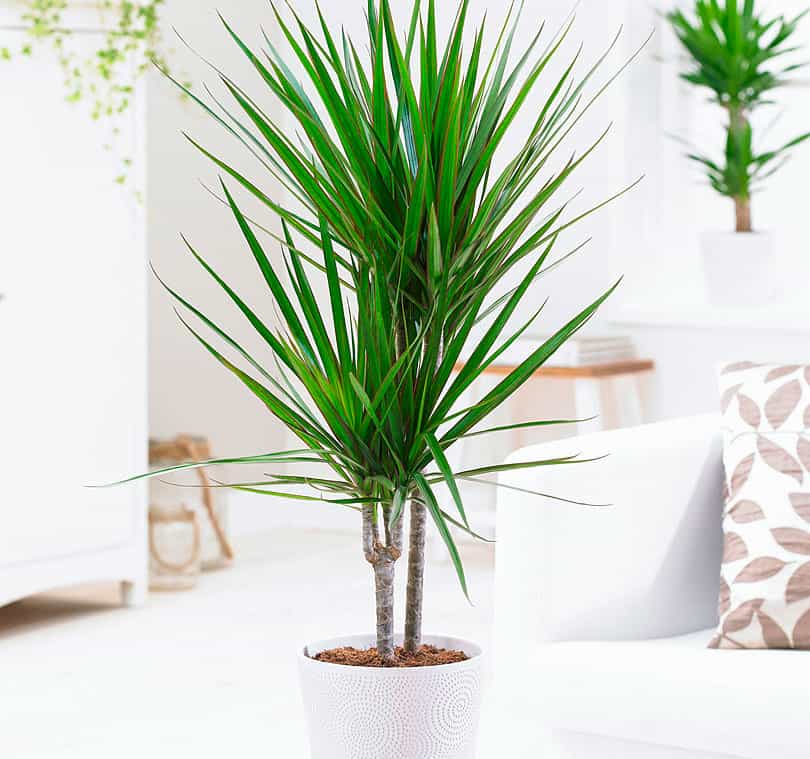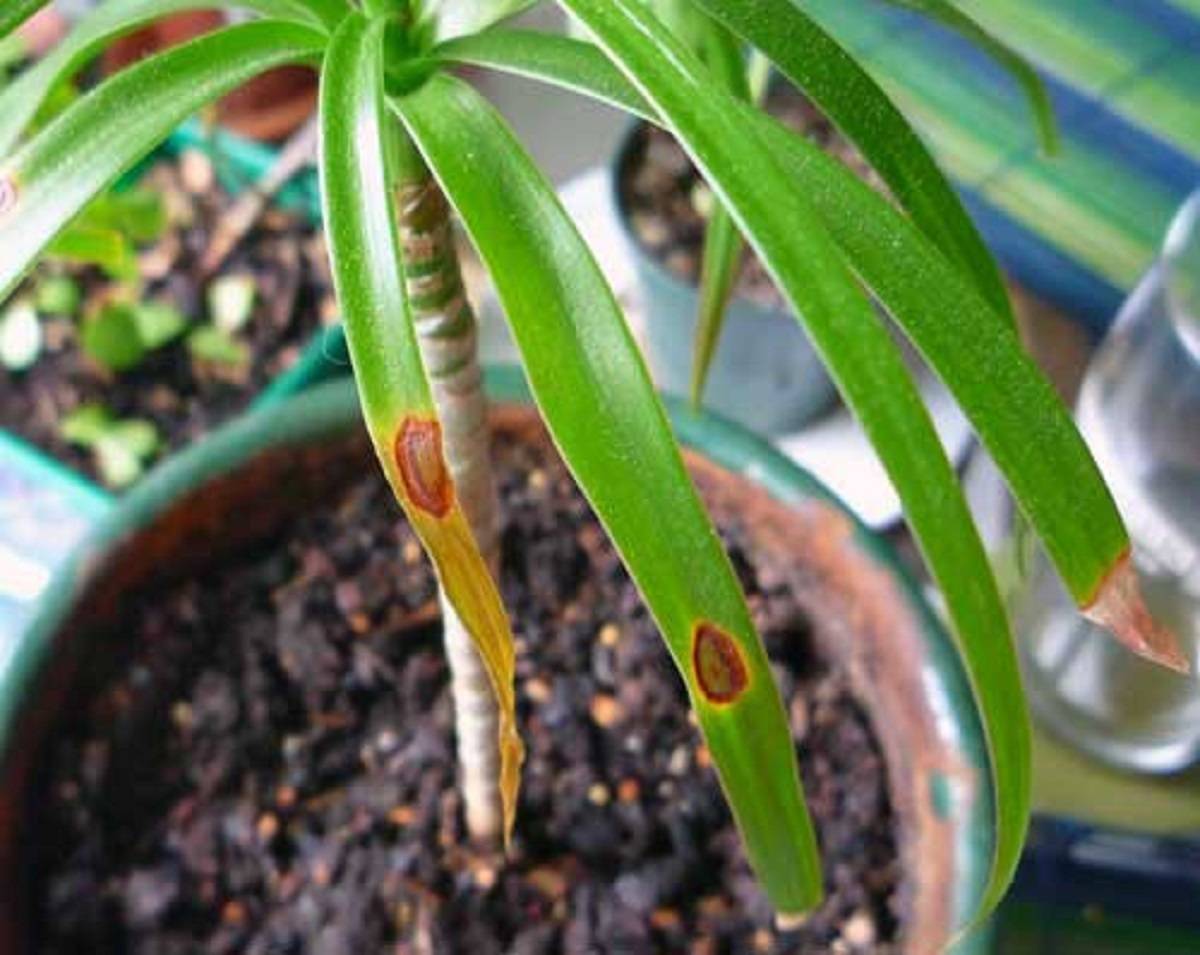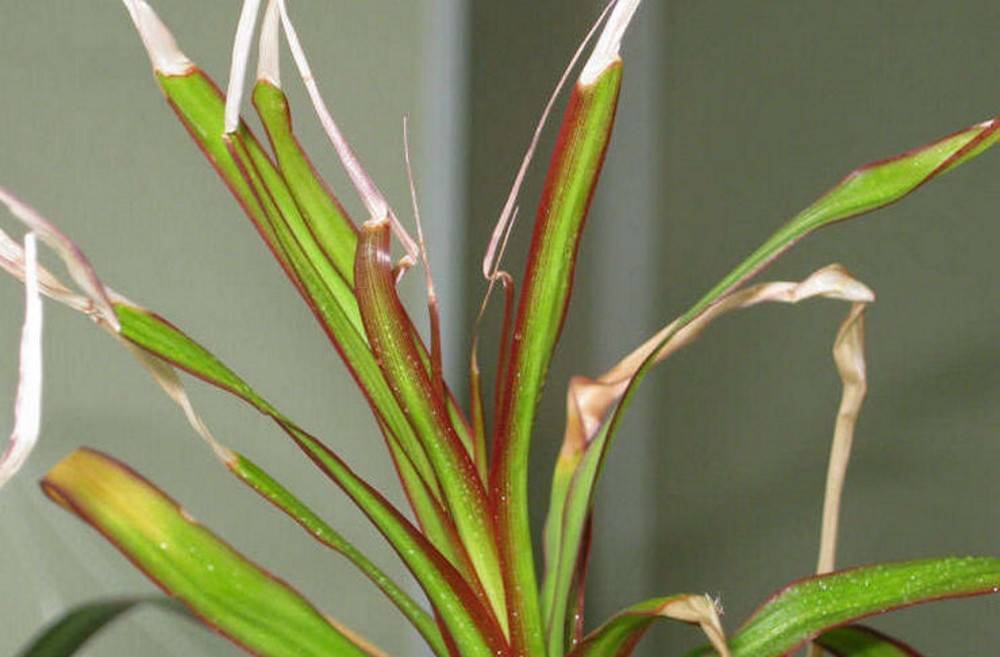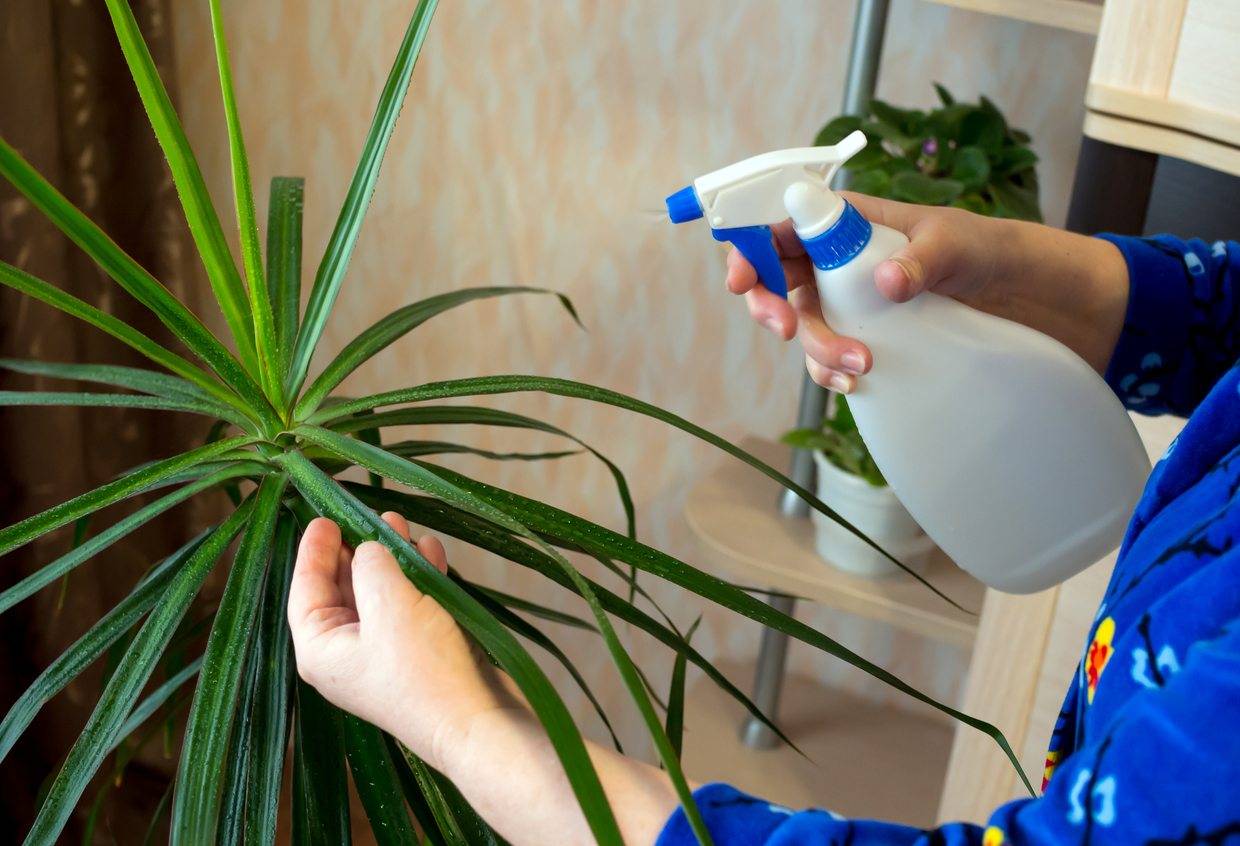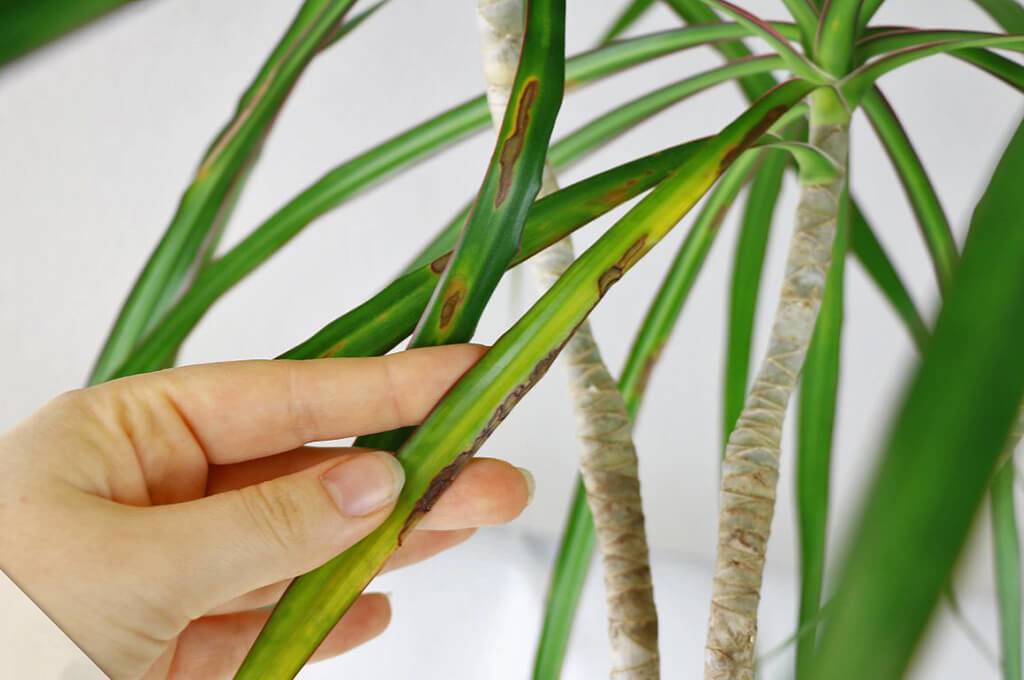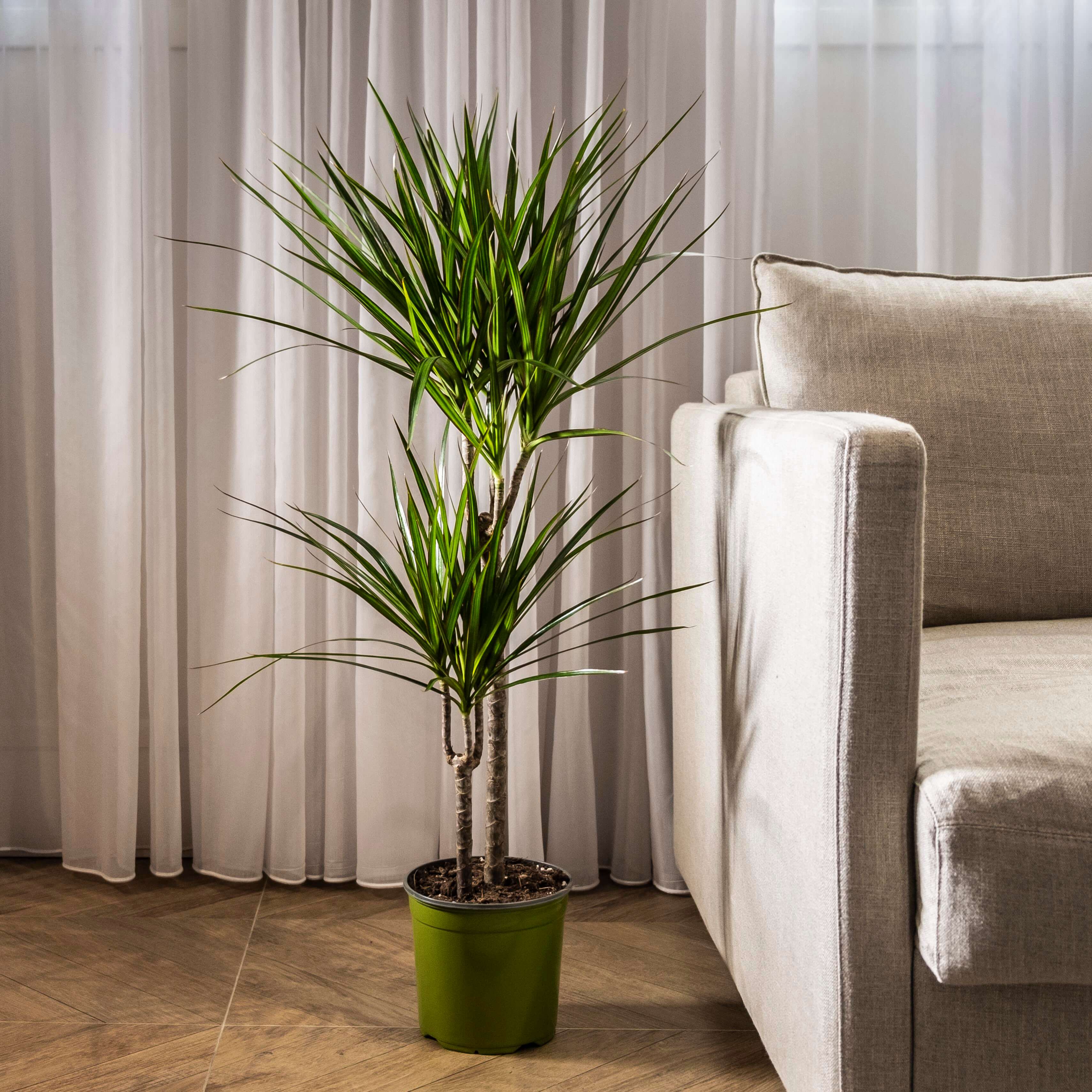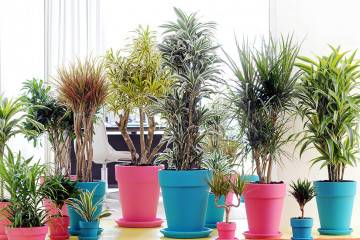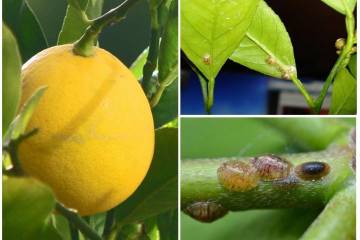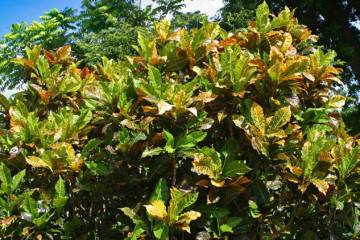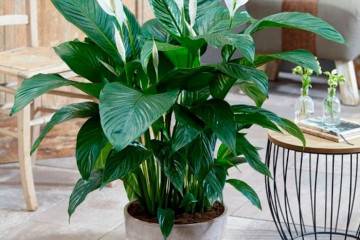Dracaena - flower diseases and how to deal with them
Content:
The flower with the beautiful name Dracaena belongs to the ornamental deciduous houseplants. Unpretentious, does not require special care. With its large enough size, this plant always stands out from other indoor flowers.
It becomes all the more important to track that the plant does not get sick, is not attacked by pests.
Why a plant can get sick
Dracaena belongs to houseplants. Despite home care, he faces a variety of diseases that can be caused by infection or pests. In order to prevent this from happening, it is recommended to inspect the plant regularly.
Drops the leaves
Dracaena foliage lasts for 2 years with good care, and periodic yellowing, falling should not bother the owner. Because it is normal for a plant in this case. If there is a factor of mass dropping of leaves and the plant is "bare" almost completely, improper watering may be the cause of the problem. This is more often paid attention to, although the reasons why the plant loses its foliage may be different. For example, this can happen if:
- the flower is frostbitten due to non-compliance with the temperature regime or if the dracaena was on the blown side;
- decay of the root system occurs;
- instead of a lack of moisture, there is a supersaturation with water with a parallel hypothermia of the soil;
- infection. Usually threatens old plants with poor care. Recommended measures for the treatment of dracaena are spraying with drugs with a 10-day stand between dampening.
Leaves turn pale, turn yellow, spots appear
Dracaena's stay in a critical condition can be expressed in the pallor of the leaves, in the fact that they begin to turn yellow. Increased concern should be caused if this occurs with young foliage. The main reason again becomes improper watering, or rather a lack of moisture. The soil in which the plant is located should not dry out. Check soil moisture from time to time. An earthen top layer with a thickness of 2-3 cm can remain dry until subsequent irrigation, but then the soil should be moist.
It happens that brown spots appear on the leaves of the dracaena. This can happen if the plant, while on the windowsill, is located in such a way that direct sunlight falls on the foliage. This means she could suffer from sunburn. On the surface of the sheet, first there are spots of a rusty tint, sticky to the touch. Then they dry out. As a result, the plant gets sick and eventually dies when ignored. You can save the dracaena by moving the pot to a shaded area and cutting off the infected leaves.
At the same time, cold air can cause a change in the color of the plant. Cold acts on a color with the same effect. The plant begins to blush, then brown. Resuscitation of the flower should be its rearrangement in a warm place with periodic spraying. Water must be defended and used warm. In more comfortable conditions, the color can quickly disappear.
Leaves or tips dry, curl and wrinkle
Many are interested in why dracaena leaves curl. Sometimes drying, darkening covers only the tips of dracaena leaves. The root cause of folding is again worth looking for in a lack of moisture, but not only. Here are some more reasons:
- drying out can occur due to salts accumulated in the soil. Dracaena roots do not receive the necessary trace elements, they are deprived of normal nutrition;
- excessive feeding will also lead to the loss of the normal state of the leaves, twisting them. An overdose of fertilizers is referred to as harmful effects on the plant. They can burn the roots, and the dracaena will die.
Compliance with all the rules for watering a flower will help to correct the situation. If dry leaves or only their tips occur, it is necessary to change the soil in the pot. Dracaena transplant can be another life-saving option.
If dryness and curling on the leaves have just appeared and have not developed too much, the plant should be periodically moistened by spraying from a spray bottle. This is especially important for the hot season.
Roots rot
Dracaena disease can come from decay of the root system. Here, the reasons may be the following factors:
- at the point of location of the plant, the temperature is too low, up to 15 ° C;
- the flower is affected by a bacterial infection. The stem starts to rot. First from the top, then the general defeat of the leaves begins. As a result, bacteriosis infects the bark of the trunk, causing it to rot from the inside. For a plant, such a process means obvious death without the ability to recover;
- bacteriosis can result from waterlogging of the soil, low plant immunity, which is caused by a lack of potassium and phosphorus, as well as due to a lack of soil acidity or increased temperature;
- decay of dracaena can come from improperly selected soil. Rotting cannot be avoided if the soil is too dense and heavy.
Problems can be avoided if dracaena is grown in compliance with the rules for care:
- check the color in time for the presence of pests, diseases;
- monitor the condition of the soil;
- observe the water balance of the soil;
- avoid hypothermia.
Wrinkled trunk
Dracaena's trunk can become soft and wrinkled. This happens if the plant is in the cold for a long time. Most gardeners know why dracaena leaves curl into a tube. They know that when the air temperature is below 18 degrees, the dracaena will begin to freeze. But stem fibers in the cold also soften, the stem begins to weaken, rot from the inside. The process of softening, shrinking does not begin immediately. First, the top begins to freeze, the leaves may become limp. At the same time, the barrel itself remains in a good solid state. If you notice in time that the top of the plant is frozen and pruning to the mark of the beginning of a healthy trunk, the dracaena can be saved. The same method is recommended by experts, answering the question of how to save the dragon tree if the top has dried up.
The most important thing to do next to achieve good plant growth:
- transfer the color to a warm place with natural sunlight, where there will be no drafts. The temperature in the area where the plant is located should range from 22 to 25 degrees Celsius;
- make top dressing using complex fertilizer.The dosage must be halved, focusing on the data in the instructions;
- spray the trunk and soil every week. Use a plant growth stimulator for this.
Observe the correct watering regime and wait for the dracaena to recover and give lateral buds. The watering regime must be observed without fail. Dracaena will gradually recover and give lateral buds.
Rot on leaves and stem
This is the result of infection of dracaena with infectious diseases. For such a plant, this is rare, since it has strong immunity. Dracaena tolerates diseases easily if they are not dangerous. But it happens that this species has such difficult problems. They are expressed in the form of dark spots on the leaves and stem.
The most common infections are fungal in nature.
Alternaria
Covers leaves with brown spots. They appear at different points of the foliage, have a rounded shape. Over time, if the plant is left untreated, the leaves and stem begin to rot quickly. They begin to turn black, they are covered with fungal spores.
You can save the plant if you start spraying with fungicides in time. Spraying should be carried out three times, skipping 10 days between treatment processes.
Heterosporosis
The disease affects leaves from both sides at once. First, yellow spots appear on the leaves of the dracaena, which are then replaced by a light brown tone with a dark frame. Further, the spots expand, the darkened fungal spores can be seen with the naked eye.
The decay process can be interrupted in the same way as in the above disease.
Phylostictosis
Dangerous for old leaves. The manifestation of the disease is brown spots on dracaena with a yellow-green edging. The neglected form is the covering of the leaves with a black bloom (a sign of fungal spores).
The main cause of rotting is abnormal air humidity. Damage is caused by both high and low humidity. In addition, the plant can be harmed by excessive watering or, on the contrary, by insufficient moisture content in the soil.
Bacteriosis
In addition to a fungal disease, bacterial infection with bacteriosis can ruin dracaena. With such an infection, softening, decay of the tips of the leaves occurs, the appearance of decaying spots on the leaves in the form of limited stripes of an oily yellow hue.
Bacteriosis affects not only the foliage, but also the stem. It is believed that this disease is one of the most dangerous. When neglected, it is not treated. The plant in this case is simply destroyed. Otherwise, the virus can spread to other flowers in the vicinity.
The cause of diseases and viruses of dracaena lies in the waterlogged soil and the surrounding air. An important role is also played by the lack of top dressing, a factor of low soil acidity. Blackness on the leaves can also occur due to a lack of nutrients in the soil.
Pests
Diseases and treatment are associated not only with infections, viruses. These factors are not the only ones that are harmful. Pests are no less dangerous for dracaena. To avoid their appearance, you should know how to properly care for the plant. How to understand in time that pests have already appeared and an urgent need to take appropriate measures?
If the color has been attacked by pests, it is worth determining their type and using an effective method for destroying a specific variety.
The most common dracaena pests can be as follows.
Shield
Insect, reaching a length of 4 mm. If you look closely, it can be identified by its protective waxy yellow-gray shell. The pest feeds on plant sap. In large quantities, scale insects dry up the stems, leaves, after which they become weak, dry up and fall off.
They fight the scabbard on dracaena with a soft sponge and a soap solution, with which the parasites are gently washed off the leaves. After washing, the plant is treated with an insecticide.
Thrips
These pests can be found on the lower parts of the leaves. They establish themselves there, organizing entire colonies. The ideal environment for thrips to multiply quickly is low humidity and high air temperatures. To expel such a pest, it is necessary to treat the plant with an insecticide, observing a break between treatments of 10 days.
Spider mite
It is considered to be one of the most unpleasant pests. It's almost microscopic. Like thrips, it gathers in the lower part of the leaf. It is rather difficult to notice it, but it betrays its presence by the fact that soon the foliage and dracaena stalk affected by it begin to become covered with a white bloom, a web appears.
A plant captured by a spider mite loses its immunity, can pick up various diseases, and stop growth. It is difficult to get rid of the tick, but the possibility of saving the plant exists. It is necessary to repeatedly treat the plants with acaricide, and before that, rinse the foliage using a hot soapy solution.
Mealybugs
The most common type of dracaena pests. Insects love plant sap. Having gathered on a leaf, they drain it, stop the growth of the flower, and prevent it from developing. It is quite easy to spot them on the leaves. Worms are white, they are also produced by a mealy white bloom on dracaena. Such a speck on a leaf is always pronounced.
Gathering in leaves, rosettes, mealybug on dracaena creates deposits similar to wax wool. You can get rid of this kind of pests manually. Again, a soap solution becomes one of the main necessary compounds, and a soft swab is required for the treatment itself. After washing, the leaves are sprayed with insecticide twice. The procedure is repeated after 14 days.
Dracaena diseases are caused by various bacteria, fungi, parasites. The list of various factors threatening the flower is extensive. You can significantly reduce the risk or completely get rid of all the prescribed negative elements if you turn to rescue measures in time. If you do everything correctly, create optimal conditions for the flower, you can not wonder why the dracaena does not grow for a long time.
